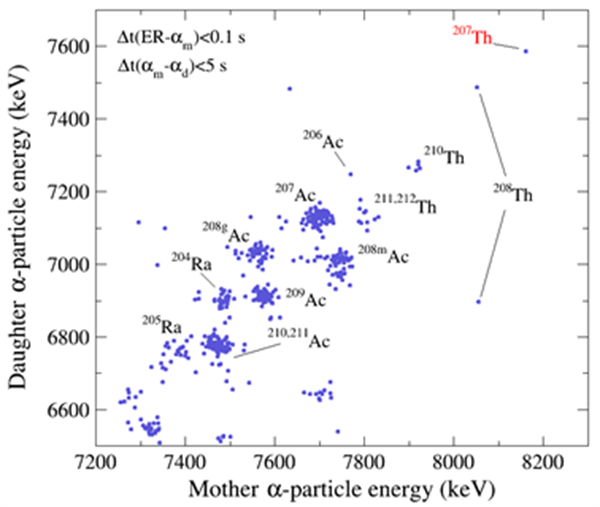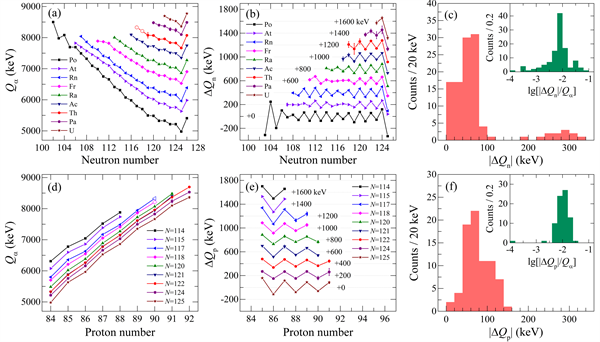

Image via Physical Review C
Researchers from the Institute of Modern Physics of the Chinese Academy of Sciences and the Institute of Theoretical Physics, Sun Yat-Sen University, Lanzhou University, Guangxi Normal University, Tongji University, and the Russian Joint Institute for Nuclear Research, on the gas-filled recoil nuclear spectrometer of the Lanzhou Heavy Ion Accelerator, through fusion evaporation Reaction 36^Ar+176^Hf (Ar is the chemical element argon, Hf is the chemical element hafnium), a new nuclide thorium-207 was successfully synthesized, and its alpha particle energy and half-life were measured, which were 8167(21)keV ( keV) and 9.7(+46.6-4.4)ms (milliseconds). The thorium-207 synthesized this time is the 34th nuclide synthesized by the Institute of Modern Physics.
36^Ar+176^Hf The two-dimensional diagram of the triple-linked chain ER-a1-a2 of the reaction product, the abscissa and ordinate represent the α particle energies of the parent nucleus and daughter nucleus, respectively, the picture comes from Yang Huabin
In addition, the aforementioned team discovered and explained a new phenomenon of the parity effect of alpha decay energy. Through the systematic analysis of the new measurement data and existing data, it is found that in the Z>82, N<126 nuclear region, the α decay energy of both isotopes and homoneutrons exhibits regular odd-even oscillations, with an oscillation amplitude of 20- 160keV. This finding contradicts the assumption that there is no parity effect in alpha decay energies, usually according to the Bethe-Weizsacker formula.In order to explore the formation mechanism of the parity effect of α decay energies, the relativistic Hartree-Fock-Bogoliubov model (RHFB) and the large-scale shell model (LSSM) were used to theoretically analyze the nuclei in the Z>82 and N<126 nuclear regions. RHFB model calculations show that the parity effect of alpha decay energy arises from the blocking effect on associated and unpaired nucleons. Among them, in addition to the pair energy, the pair correlation also affects the odd-even oscillation of the decay energy through nucleon scattering. The LSSM model results show that the parity effect of the alpha decay energy is caused by the mixing of configurations containing special orbitals. Neither the nucleon scattering in the RHFB model nor the configuration mixing in the LSSM model are beyond the theoretical framework of the mean field and are not included in the classical Bethe-Weizsacker formula.

The parity effect of α decay energy, (a) the variation of α decay energy from the ground state of the neutron-deficient Po-U isotope to the ground state with the number of neutrons; (b) the odd-even oscillation of the α decay energy extracted by the three-point formula along the isotope chain ; (c) Amplitude distribution of isotope odd-even oscillation; (d) Variation of α decay energy from ground state to ground state with neutron number; (e) odd-even oscillation of α decay energy along the homoneutron chain; (f) The amplitude distribution of odd-even oscillations in the same neutron prime, the picture comes from the University of Science and Technology of China
The aforementioned studies have synthesized a new nuclide thorium-207, and revealed the reason for the odd-even effect of α decay energy, which requires further improvement of the nuclear mass formula.